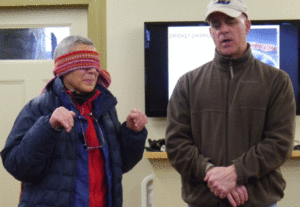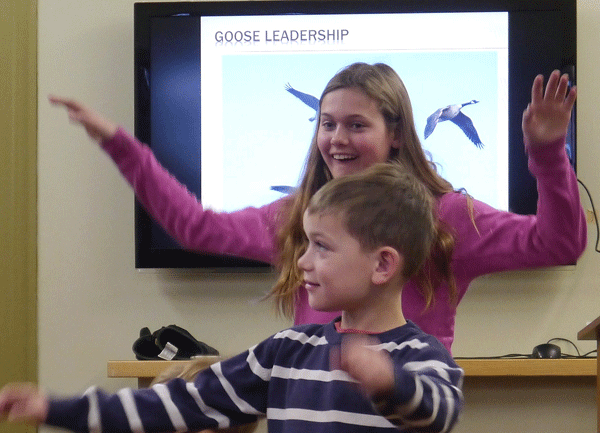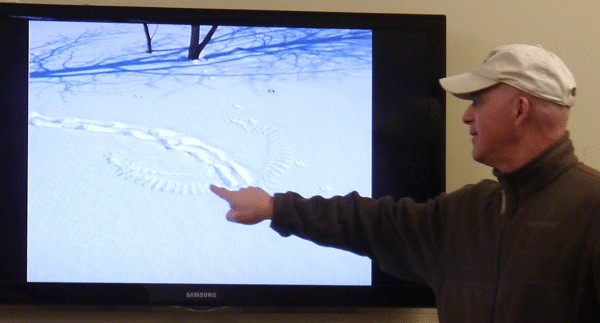Wilderness Alive demonstrates easy ways to re-connect with fun in nature
Administrator | Jan 09, 2018 | Comments 0
Story and photos by Sharon Harrison
The lucky few who braved the sub-zero elements Friday afternoon were rewarded with fun ways to engage with nature during Jacob Rodenburg’s presentation ‘Wilderness Alive’ at the Picton branch library.
Rodenburg noted the average child can identify over 1,000 corporate logos, but only 10 native plants or animals – which he says is a telling indictment of a modern disconnection from nature.
The small but enthusiastic gathering was entertained and delighted for about an hour with a free presentation on nature and wilderness, outdoor play and activities. Rodenburg is keen to “teach kids about what’s going on in the seasons, a little about nature, activities and appreciating the environment.”
Nature can be explored all year round and Rodenburg spoke about fun in each season. Participants learned how to make a print of a mushroom by placing a mushroom head on a piece of paper with the gills down, and putting a glass over it. Leave it for 24 hours and all the spores fall down on the paper to form a pattern.
Using Bristol board and hair spray, Rodenburg described how to capture a spider’s web. He noted that it takes a lot of energy for a spider to make a web and a piece of spider’s web is stronger than a length of steel of the same size. He also shared how a spider will often eat their own web as it provides a source of protein which gives them energy to make a new web.
Pishing—or bird whispering—is the art of imitating a bird call. The captive audience practiced different bird calls as well as learning how bird sounds change when birds are alarmed. For example, the more threatened a chickadee feels, the more “dees” its call will contain.
Rodenburg explained how a bird’s song is different to its call, how different birds have different sounds, how male birds sound different to females and how easy it is attract chickadees in large numbers just be making the right call.
With eager young participants willing to join in the fun, Rodenburg demonstrated goose flight patterns, showing how and why geese fly in the manner they do. Positioning makes it easier to fly using the updraft from the goose in front and how the lead goose takes turns to conserve energy.
Rodenburg explained people can learn a lot from geese.
“Geese can teach us about working together and as a team,” said Rodenburg. Geese look out for each other and take care of one another. “Everyone cooperates, encourages each other, they have a good work ethic, take care of each other, we can learn a lot of good lessons from geese,” added Rodenburg.

Blindfolded audience member demonstrating how to identify different cricket chirrups with Jacob Rodenburg.
He demonstrated different cricket chirrups as one blindfolded participant successfully searched and identified a specific cricket sound among many. Audience members were asked to collectively demonstrate a different call using a piece of wood run along the teeth of comb to represent a unique cricket chirping pattern, much to the amazement of the youngest audience members.
“The snow tree cricket lives in this area and is known as the thermometer cricket”, said Rodenburg, adding, “The extremely steady and measured chirp is pretty accurate at providing the temperature as the colder it is, the slower the chirps, and the warmer it is, the faster the chirps.” Rodenburg suggested testing the theory: count the number of chirps in eight seconds and add five and you arrive at the temperature in Celsius.
In similar fashion, everyone participated in a frog orchestra demonstrating various frog calls.
Whether it’s learning how to make a bird’s nest from mud and string, how to hypnotize a frog, or calling worms up from the ground (known as worm fiddling), the afternoon was educational, awe-inspiring and interesting.
Rodenburg also explained how a ‘seed sock walk’ works as seeds stick to fabrics while walking through the bush or the forest as one example of enabling seed distribution. “Put a sock pulled over a shoe, take a walk in a field and see what sticks to the sock,” said Rodenburg.
As executive director at Camp Kawartha, Queen’s University educated Rodenburg has spent 30 years teaching outdoor education and currently teaches part-time at Trent University. His enthusiasm for the great outdoors is apparent as he shares his excitement for all things nature with those of all ages and abilities.
Rodenburg is also co-author of the award-winning The Big Book of Nature Activities, “a rich, fully-illustrated compendium and comprehensive guide for parents and educators to help youth of all ages explore, appreciate and connect with the natural world.” The publication is “packed with crafts, stories, information and inspiration to make outdoor learning fun.”
The presentation was hands-on, interactive and lots of fun as participants learned about various ways to play outdoors (and indoors) especially during the winter months. Exploring nature-based skills and activities, Rodenburg demonstrated a variety of nature activities to be enjoyed through the winter months suited to the whole family.
Winter brings unique opportunities for nature exploring as Rodenburg explained how to identify different animal tracks in the snow, how to determine which direction an animal is travelling in as well as determining an animal’s activity from imprints and clues left behind in the snow.
“One of the things I love to do is to teach kids about tracking,” said Rodenburg, adding “Animal tracks in the winter time tell stories.” Animals may be running, walking or hunting as Rodenburg explained how animals leave a story behind from their tracks in the snow. “Sometimes if you aren’t sure which way in animal is going from its tracks in the snow, look for scuff marks. When we walk, animals too, we tend to drag our heel a bit so they leave a scuff mark at the heel.”
A number of examples of winter projects included ice candle making using a balloon filled with water left outside overnight, making tea from evergreens or using ice to make unique sculptures, as well as how to make a frozen mandala using an empty tuna can and a piece of plant material to hang in a tree outside.
Everyone in the group made six-sided paper snowflake and also learned how to catch a real snowflake on laminated Bristol board and examine it up close using a magnifying glass.
Rodenburg encourages all young people to become citizen scientists and to explore the many resources available for discovering, appreciating and learning all about nature and wildlife. Most of all, he is a great proponent for getting outdoors, enjoying, learning and preserving nature and having fun at the same time.
Rodenburg hopes to return to the library for a repeat presentation when the County weather is a little kinder. In the meantime, The Big Book of Nature Activities: A Year-Round Guide to Outdoor Learning written by Drew Monkman and Jacob Rodenburg, published July 2016, is available at the Prince Edward County Library or by special order at Books and Company in Picton.
Filed Under: News from Everywhere Else
About the Author:


































